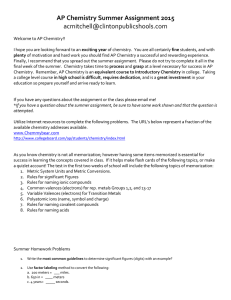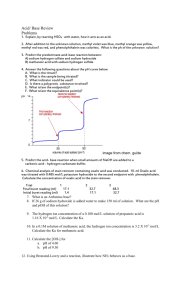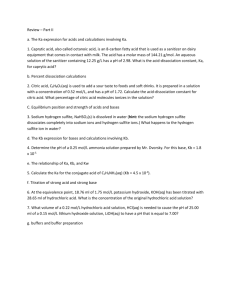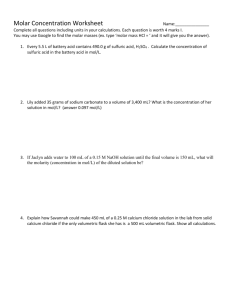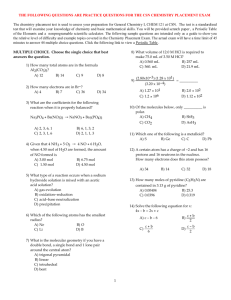AP Chem Summer HW 2015
advertisement
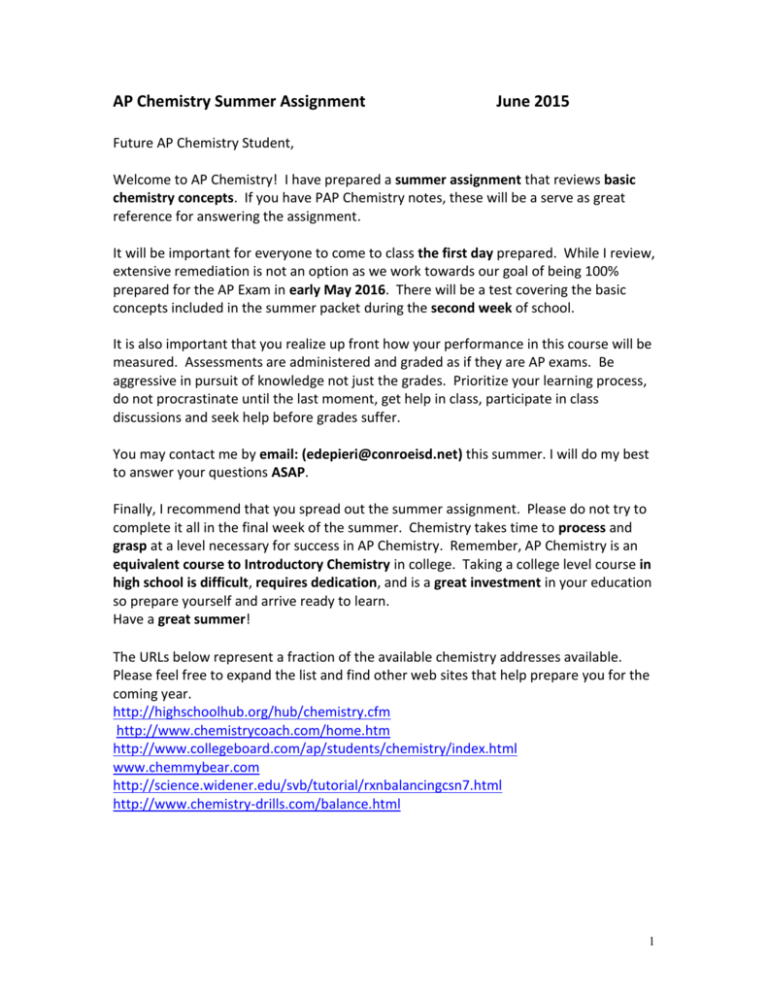
AP Chemistry Summer Assignment June 2015 Future AP Chemistry Student, Welcome to AP Chemistry! I have prepared a summer assignment that reviews basic chemistry concepts. If you have PAP Chemistry notes, these will be a serve as great reference for answering the assignment. It will be important for everyone to come to class the first day prepared. While I review, extensive remediation is not an option as we work towards our goal of being 100% prepared for the AP Exam in early May 2016. There will be a test covering the basic concepts included in the summer packet during the second week of school. It is also important that you realize up front how your performance in this course will be measured. Assessments are administered and graded as if they are AP exams. Be aggressive in pursuit of knowledge not just the grades. Prioritize your learning process, do not procrastinate until the last moment, get help in class, participate in class discussions and seek help before grades suffer. You may contact me by email: (edepieri@conroeisd.net) this summer. I will do my best to answer your questions ASAP. Finally, I recommend that you spread out the summer assignment. Please do not try to complete it all in the final week of the summer. Chemistry takes time to process and grasp at a level necessary for success in AP Chemistry. Remember, AP Chemistry is an equivalent course to Introductory Chemistry in college. Taking a college level course in high school is difficult, requires dedication, and is a great investment in your education so prepare yourself and arrive ready to learn. Have a great summer! The URLs below represent a fraction of the available chemistry addresses available. Please feel free to expand the list and find other web sites that help prepare you for the coming year. http://highschoolhub.org/hub/chemistry.cfm http://www.chemistrycoach.com/home.htm http://www.collegeboard.com/ap/students/chemistry/index.html www.chemmybear.com http://science.widener.edu/svb/tutorial/rxnbalancingcsn7.html http://www.chemistry-drills.com/balance.html 1 Name __________________________________ # _____ Class Period ____ Show work for all the problems. USE SIGNIFICANT FIGURES in problems. 1. Write the significant figure guidelines to determine significant figures. Provide an example of each rule being applied. 2. Why are significant figures important in reporting measurements? 3. Use dimensional analysis method to convert the following: a. 200 meters = ___ m b. 650 nm = ____ meters c. 4 years= _____ seconds d. 200 liters = _____ cm3 4. Classify each of the following as units of mass, volume, length, density, energy, or pressure. a. Kg b. Liter c. m3 d. mm e. Joule f. atm g. cal. h. Torr i. g/mL j. kPa 5. Most laboratory experiments are performed at room temperature at 25˚C. Express this temperature in: a. oF b. Kelvin 6. A cylinder rod formed from silicon is 46.0 cm long and has a mass of 3.00 kg. The density of silicon is 2.33 g/cm3. What is the diameter of the cylinder? (the volume of cylinder is given by ∏ r2h, where r is the radius and h is the length) 2 7. How many significant figures are in each of the following? 6.22 mm _____ 0.0301001 kJ _____ 6.022 x1023 atoms _____ 10000 _____ 1001 _____ 0.0101_____ 460.000 L _____ 0.000036 cm3 _____ 0.001345 _____ 3.02 x 104 _____ 3.21 x 10-2_____ 8. Write the following in correct scientific notation: a. 4050,000,000 cal _____________________ b. 0.000123 mol _____________________ c. 0.00345 Ǻ _____________________ d. 700,000,000 atoms_____________________ 9. Calculate the following to the correct number of significant figures. a. 1.270 g / 5.296 cm3 _____________________ b. 12.235 g / 1.010 L _____________________ c. 12 g + 0.38 g _____________________ d. 170g + 2.785 g _____________________ e. 2.1 x 3.2102 _____________________ f. 200.1 x 120 _____________________ g. 17.6 + 2.838 + 2.3 + 200 _____________________ 10. Give the chemical symbols for the following elements: a. Carbon _____ b. sulfur _____ c. Titanium _____ d. Nitrogen _____ e. Helium _____ f. Krypton _____ g. Fluorine _____ h. Scandium _____ i. Arsenic _____ j. Potassium _____ k. Sodium _____ l. chlorine _____ 11. A solid white substance A is heated strongly in the absence of air. It decomposes to form a new white substance B and a gas C. The gas has exactly the same properties as the product obtained when carbon is burned in an excess of oxygen. Based on these observations, can we determine whether solids A and B and the gas C are elements or compounds? Explain your conclusions for each substance. 3 12. Label each of the following as either a physical process or a chemical process. a. Corrosion of aluminum metal. _____________________ b. Melting of ice. _____________________ c. Pulverizing an aspirin. _____________________ d. Digesting a candy bar. _____________________ e. Explosion of nitroglycerin. _____________________ f. Milk turning sour. _____________________ g. Burning of paper. _____________________ h. Forming of frost on a cold night. _____________________ i. Bleaching hair with hydrogen peroxide._____________________ j. A copper wire is hammered flat. _____________________ 13. You may notice when water boils, you can see bubbles that rise to the surface of the water. a. What is inside these bubbles? b. Is the boiling of water a chemical or physical change? Explain c. Draw a particulate drawing showing water in the liquid state as stabilized by Hydrogen bonds. 14. Dalton assumed that all atoms of the same element were identical in all their properties. Explain why this assumption is not valid. 15. Why do we call Ba(NO3)2 barium nitrate, but we call Fe(NO3)2 iron(II) nitrate? 16. Calculate the mass of O2 produced if 3.450 g potassium chlorate is completely decomposed by heating in presence of a catalyst (Manganese dioxide). 4 17. Write the formula of the following compounds? a. Calcium sulfate. b. Ammonium Phosphate __________________ __________________ d. potassium perchlorate. e. Barium Oxide __________________ __________________ g. Sodium Perbromate h. Calcium Iodide __________________ __________________ c. Lithium Nitrite __________________ f. Zinc sulfide. __________________ i. Aluminum Carbonate. __________________ 18. Convert 6.75 atm to: (Using dimensional analysis method) a. torr Hg b. kilopascals c. mm of Hg 19. Define the following terms: atomic number _________________________________________________________________ atomic mass ___________________________________________________________________ mass number __________________________________________________________________ molecular formula ______________________________________________________________ structural formula _______________________________________________________________ empirical formula _______________________________________________________________ isotopes _______________________________________________________________________ cation _________________________________________________________________________ anion _________________________________________________________________________ metalloid ______________________________________________________________________ allotrope ______________________________________________________________________ 20. Determine number of protons and neutrons in each of the following. a. 3919K b. 2311Na c. 20882Pb d. 3315P p+: _______________________________________________________ n: ________________________________________________________ 5 21. White gold is an alloy that typically contains 45.0% by mass gold and the remainder is platinum. If 154 g of gold are available, how many grams of platinum are required to combine with the gold to form this alloy? 22. What is the empirical formula of a compound that contains 53.73% Fe and 46.27% of S? 23. Determine the number of molecules present in 4.56 mol of nitrogen gas. 24. Classify the following as diatomic element, molecular compound, ionic compound, or element. a. F2 b. Cl2 c. C d. NaCl e. KF f. CO2 g. H2 h. Ag i. Rust (Fe2O3) j. MgO k. O2 l. I2 m.CO n. K2CO3 25. Illustrate (using a drawing) the difference between: a. Chlorine and Chloride? b. Sodium atom and sodium ion? 26. How many grams of methane are present in 5.6 moles of methane gas? (use dimensional analysis) 27. Calculate the mass in grams of each of the following: a. 6.02 x 1023 atoms of Mg. b. 3.01 x 1023 Formula units of CaCl2. c. 12.4 x 1015 atoms of Neon. 6 28. In an experiment, a student gently heated a hydrated copper compound to remove the water of hydration. The following data was recorded: 1. Mass of crucible, cover, and contents before heating 23.4 g. 2. Mass of empty crucible and cover 18.82 g. 3. Mass of crucible, cover, and contents after heating to constant mass 20.94 g. Calculate the experimental percent of water in the compound. 29. An extensive property is one that depends on the amount of the sample. Circle the properties that are extensive. a. volume b. density c. temperature d. energy e. melting point. f. pressure 30. A hydrated compound has an analysis of 18.29% Ca, 32.37% Cl, and 49.34% water. What is its empirical formula? 31. Define and give examples of each: Acid _________________________________________________________________ Base _________________________________________________________________ Salt _________________________________________________________________ 32. What mass of copper is required to replace silver from 4.00g of silver nitrate dissolved in water? Cu(s) + AgNO3 → Cu(NO3)2 + Ag 7 33. Write the chemical formulas for the following compounds: a. Calcium Carbonate b. Ammonium Phosphate c. Sodium Chloride d. Sodium Oxide _____________________________________________________________________________ e. Calcium Sulfate f. Sodium Nitrite g. Magnesium Acetate h. Potassium cyanide _____________________________________________________________________________ i. Zinc(II) Nitrate j. Iron(III) Phosphate k. Nickel (II) Fluoride _____________________________________________________________________________ 34. Define a. Law of conservation of mass. _________________________________________________________________ b. Law of multiple proportion. _________________________________________________________________ 35. Strontium consists of four isotopes with masses and their percent abundance of: 83.9134 amu ( 0.5%), 85.9094 amu (9.9%) , 86.9089 amu (7.0 %) , and 87.9056 amu (82.6 %). Calculate the atomic mass of Sr. 36. Nitrogen has two isotopes, N-14 and N-15, with atomic masses of 14.00031 amu and 15.001 amu, respectively. What is the percent abundance of N-15? 37. Calculate the molar masses (g/mol) of a. Ammonia ( NH3) b. Baking soda ( NaHCO3)) c. Osmium Metal (Os) _____________________________________________________________________________ 8 38. Convert the following to moles a. 3.86 grams of Carbon dioxide _____________________________________________________________________________ b. 6.0 x 10 5g of Hydrazine (N2 H4) _____________________________________________________________________________ 39. The molecular formula of morphine, a pain-killing narcotic, is C17H19NO3. a. What is the molar mass? b. What is the percent composition? 40. Determine the molar mass for the following: a. N2O5 b. CuSO4 c. Ca(HCO3)2 d. CaSO4. 2 H2O _____________________________________________________________________________ 41. Calculate the mass percent of the following compounds: a. Sulfur trioxide b. CH3COOCH3 c. Ammonium Nitrate. 9 42. Determine the empirical formula of the compounds with the following percent compositions: a. 10. 4 % C, 27. 8% S , 61. 7 % Cl b. 21.7 % C, 9.6 % O, and 68.7 % F 43. Arsenic reacts with chlorine to form a chloride. If 1.587 g of arsenic reacts with 3.755 g of chlorine, what is the simplest formula of the chloride? 44. Vanillin, a flavoring agent, is made up of carbon, hydrogen, and Oxygen atoms. A sample of Vanillin weighing 2.500g burns in Oxygen, 5.79 g of carbon dioxide and 1.18 g of water are obtained. What is the empirical formula of Vanillin? 45. What is the molecular formula of each of the following compounds? a. Empirical formula CH2 , molar mass =84g/mol. b. Empirical formula NH2Cl, Molar mass = 51.5 g/mol 10 46. Determine the empirical and molecular formula of each of the following substances: a. Ibufuren, a headache remedy contains 75.6 % C, 8.80 % H , and 15.5 % O by mass and has a molar mass about 206 g/mol. b. Epinephrine, a hormone secreted into the bloodstream in times of danger or stress, contains 59% C, 7.1% H, 26.2% O, and 7.7% N by mass, its MW is about 180 amu. 47. Write a balanced equation for the following: a. Reaction of boron trifluoride gas with water to give liquid hydrogen fluoride and solid boric acid,(H3BO3). ________________________________________________________________________ b. Reaction of magnesium Oxide with Iron to form Iron (III) Oxide and Magnesium. ________________________________________________________________________ c. The decomposition of Dinitrogen Oxide gas to its elements. ________________________________________________________________________ d. The reaction of Calcium Carbide solid with water to form calcium hydroxide and acetylene (C2H2) gas. ________________________________________________________________________ e. The reaction of solid calcium cyan amide (CaCN2) with water to from calcium carbonate and ammonia gas. ________________________________________________________________________ f. Ethane burns in air (Oxygen). ________________________________________________________________________ g. Hydrogen reacts with oxygen to from Water. ________________________________________________________________________ 11 h. Nitrogen gas reacts with Hydrogen to form Ammonia. ________________________________________________________________________ i. Hydrogen reacts with Iodine gas to form Hydrogen Iodide. ________________________________________________________________________ j. Sodium reacts with Iodine gas to form Sodium Iodide. ________________________________________________________________________ k. Carbon dioxide combines with water to form carbonic acid. ________________________________________________________________________ 48. DEFINE limiting reagent ________________________________________________________________________ theoretical yield ________________________________________________________________________ actual yield ________________________________________________________________________ 49. Sodium hydroxide reacts with carbon dioxide as follows: 2 NaOH(s) + CO2 (g) → Na2CO3 (s) + H2O(l) Which reagent is the limiting reactant when 1.85 mol of sodium hydroxide and 1.00 mol carbon dioxide are allowed to react? How many moles of sodium carbonate can be produced? How many moles of the excess reactant remain after the completion of the reaction? 12 50. When benzene (C6H6) reacts with bromine (Br2) bromobenzene (C6H5Br) is obtained: C6H6 + Br2 → C6H5Br + HBr a. What is the theoretical yield of bromobenzene in this reaction when 30.0g of benzene reacts with 65.0 g of bromine? b. If the actual yield of bromobenzene was 56.7 g what was the percentage yield? 51. One way to remove Nitrogen Oxide (NO) from smokestack emissions is to react it with ammonia: 4 NH3 (g) + 6 NO (g) --------> 5 N2 (g) + 6 H2O (l) Fill in the blanks below: a. 12.3 mol of NO reacts with _____ mol of ammonia. b. 5.87 mol NO yields _______ mol nitrogen. 52. Chlorine and Fluorine react to form gaseous chlorine trifluoride. You start with 1.75 mol of chlorine and 3.68 mol of fluorine. a. Write the balanced equation for the reaction. b. What is the limiting reactant? 53. A 2.0g sample of SX6 (g) has a volume of 329.5 cm3 at 1.00 atm and 20oC. Identify the element ‘X’. Name the compound. 13 54. When Hydrogen sulfide gas, H2S, reacts with oxygen, Sulfur dioxide gas and steam are produced. a. Write the balanced chemical equation for this reaction. c. How many liters of sulfur dioxide would be produced from 4.0 L of Oxygen? Assume 100% yield and that all gases are measured at standard temperature and pressure. 55. Hydrogen cyanide, HCN is a poisonous gas. It can be formed by the reaction: NaCN (s) + H+ (aq) ---------> HCN (g) + Na+ (aq) What mass of sodium cyanide is required to make 8.5 L of HCN at 22oC and 751 mm Hg? 56. A gaseous mixture contains 5.78 g of methane, 2.15 g of neon, and 6.8 g of sulfur dioxide. What pressure is exerted by the mixture inside a 75.0 L cylinder at 85oC and 751 mm Hg? 57. A sample of Methane gas is at 50.oC and 20. atm. Would you expect it to behave more ideally or less ideally at each of the following conditions? Justify your answer. a. The pressure was reduced to 1 atm. b. The temperature were reduced to – 50.oC? 58. Name the following: a. CO2 _____________ b. P4S10 _____________ c. NI3 _____________ d. PCl5 _____________ e. CCl4 _____________ f. SF6 _____________ g. CH4 _____________ h. C2H6 _____________ i. N2O3 _____________ 14 59. Define Oxidation and reduction. Provide at least five examples of oxidation and reduction with chemical reactions. (Example: Rusting of Iron; 4Fe + 3O2 → 2Fe2O3) 60. Define Oxidation number. Find the Oxidation number of a.Carbon in CO2_____________ b.Sulfur in H2SO4_____________ c.Phosphorus in PO43-_____________ d.Manganese in MnO42-_____________ 61. Which of the following statements are always true? Never true? Not always true? a. A compound with the molecular formula C6H6 has the same simplest formula. b. The mass percent of copper in CuO is less than in Cu2O. c. The limiting reactant is the one present in the smallest number of grams. d. Since C3H6O3 and C6H12O6 reduce to the same formula, they represent the same compound. 62. A bedroom 11 ft x 12 ft x 8.0 ft contains 35.41 kg of air at 25˚C. Express the volume of the room in liters, the amount of air in moles (molar mass of air is 29.0 g/mol) and the temperature in Kelvin. 63. A sample of carbon dioxide gas, CO2 (g), occupies a volume of 5.75 L at 0.890 atm. If the temperature and the number of moles remain constant, calculate the volume when the pressure a. increased to 1.25 atm b. decreased to 0.350 atm 64. A nitrogen sample at 30˚C has a volume of 1.75L. If the pressure and the amount of gas remain unchanged, determine the volume when the Celsius temperature is doubled. 15 65. An open flask contains 0.200 mol of air. Atmospheric pressure is 745 mmHg and room temperature is 68˚C. How many moles are present in the flask when the pressure is 1.10atm and the temperature is 33˚C? 66. On a warm day, an amusement park balloon is filled with 47.8 g He. The temperature is 33˚C and the pressure in the balloon is 2.25 atm. Calculate the volume of the balloon. 67. A drum use to transport crude oil has a volume of 162 L. How many water molecules, as steam, are required to fill the drum at 1.00 atm and 100˚C? What volume of liquid water (density of water is 1.0 g/cm3) is required to produce that amount of steam? 68. Calculate the densities of the following gases at 27˚C and 763 mmHg: a.Carbon monoxide b.Chlorine gas 69. Define strong electrolyte, weak electrolyte, and nonelectrolyte. Give two examples of each. 70. What is an Activity series of metal? How does it help us in studying properties of elements? 16 71. A volatile liquid (one that evaporates readily) is put into a jar and the Jar is then sealed a. Does the mass of the sealed jar and its contents change upon the vaporization of the liquid? b. Draw a particulate drawing of the system at equilibrium. 72. Identify each of the following as being most like an observation, a law, or a theory. a. All coastal areas experience two high tides and two low tides each day. b. The tides in Earth’s oceans are caused mainly by the gravitational attraction of the moon. c. Yesterday, high tide in San Francisco Bay occurred at 2.43 a.m. and 3.07 P.m. d. Tides are higher at the full moon and ne moon than at other times of the month. 73. Define the terms: Exothermic, endothermic reactions and draw potential energy diagrams illustrating each reaction type. 74. How much heat is required to raise the temperature of 100. grams of water (Cp = 4.184J/gOC) from 25oC to 82oC? 75. A piece of unknown metal with mass 14.9 g is heated to 100oC and dropped into 75.0 g of water (Cp = 4.184J/gOC) at 20oC. The final temperature of the system is 28oC. What is the specific heat of the metal? 17 76. Define the following terms: Solute ________________________________________________________________________ Solvent ________________________________________________________________________ Molarity_______________________________________________________________________ Molality________________________________________________________________________ Mole fraction___________________________________________________________________ Mass percent___________________________________________________________________ 77. Calculate the molarity of a solution that contains 0.0345 mol NH4Cl in 400. mL of solution? 78. Calculate the molarity of a solution that contains 20.0grams of sodium hydroxide in 200mL? 79. How many grams of solute are present in 50.0 ml of 0.360 M sodium chloride? 80. The compound adrenaline contains 56.7 % C, 6.56 % H, 28.37% O and 8.28 % N by mass. What is the empirical formula for adrenaline? 18 81. DDT, an insecticide harmful to fish, birds, and humans, is produced by the following reaction: 2C6H5Cl + C2HOCl3 → C14H9Cl5 + H2O If 1142 g of C6H5Cl is reacted with 485 g of C2HOCl3. a. What mass of DDT is formed? b. Which reactant is limiting? Which is in excess? c. What mass of excess reactant is left over? d. If the actual yield of DDT is 200.0 g, what is the percent yield? 82. A 2.25 g sample of scandium metal is reacted with excess hydrochloric acid to produce 0.1502 g hydrogen gas. What is the formula of the scandium chloride produced in the reaction? 83. What volume of 0.100 M HCl solution is needed to neutralize 50.0 ml of 0.350 M KOH? 84. What is the pH, pOH , [H+], and [OH-] of a 0.557M nitric acid solution? 85. If a solution of acetic acid has a pH of 3.80, what is its [H+]? 19 86. Write the net ionic equation for the reaction between sulfuric acid solution and sodium bicarbonate solution. 87. Write the net ionic equation for the reaction between solutions of plumbous nitrate and potassium carbonate. Name the precipitate formed. 88. Write the net ionic equation for the reaction between liquid Bromine and lithium iodide solution. What species was reduced? What species was oxidized? 89. Write the net ionic equation for the reaction between hydrochloric acid and zinc metal. What species was reduced? What species was oxidized? 90. Differentiate between what happens when the following are dissolved in water. Describe the intermolecular forces associated with each solute-solvent interaction. a. Polar solute vs. non polar solute. b. KF vs. c. RbCl CO2 vs. AgCl Precious thought: “Success is to be measured not so much by the position reached in life, as by the obstacles overcome while trying to succeed.” –Booker T. Washington 20
